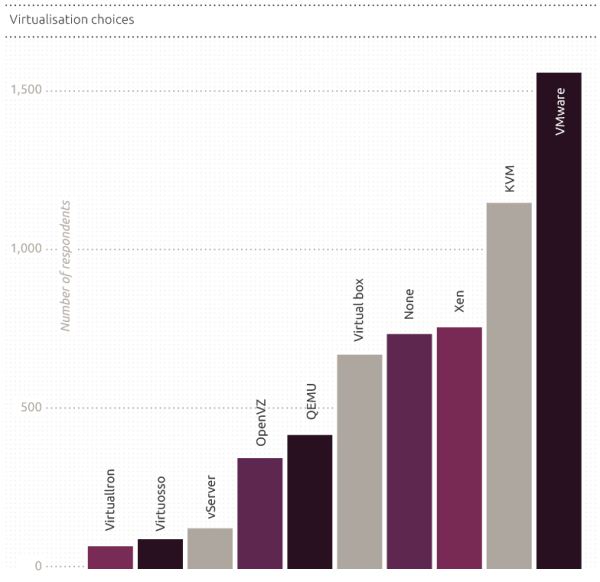Virtualized or Not? We've Got Numbers
by Johan De Gelas on February 15, 2012 9:24 AM EST- Posted in
- IT Computing
- Virtualization
- Cloud Computing
We have had epic discussions with quite a few readers about the importance of virtualization in our reviews. In our six-core Opteron review we wrote:
"Let there be no misunderstanding: how well a new Server CPU handles virtualization determines whether it is a wallflower or a blockbuster."
Even back in 2008, IDC expected that 52% of the servers would be used for virtualization, but in other reports the numbers were significantly lower. For example, more recently (April 2011) IDC reported that about 20% of all newly purchased servers are used in virtualized environments. No doubt there is some confusion between buying a server for virtualization and the numbers of workloads that find a home in a VM. IDC reports (Dec 2010) that more than 70% of applications are running inside a VM, but there is more.
The 20% virtualized servers number seems low, but you have to drill down a bit in the data. First of all, when we focus on the "mature" markets (US, Europe, Japan, Parts of Asia) the percentage of virtualized servers rises to 30%. And if you then take into account that a few players, such as Google (installed base of 1 million servers), facebook (100k+ servers) and Intel (100k+ servers) are buying massive amounts of non-virtualized servers, you can understand the percentage of virtualized servers is a lot higher among the rest of the server market. In other words, if you do a survey among the server buyers (instead of looking at the server volumes), the percentage of people buying a server for virtualization is much higher. In fact, when we talked to several analysts they indicated that if you ignore the Googles and Facebooks of the earth, the virtualization rate of servers might be as high as 70%.
Not convinced yet? Well, luckily for us Canonical did a survey among 6000 (!) users of Ubuntu Server. Interestingly, 50% of the respondents stated that they use Ubuntu server as a guest OS inside a VM, in other words it runs virtualized. Although this is only a (small) part of the total server market, it is another datapoint that gives us an idea what these Opteron and Xeon boxes are used for.
Interestingly, VMware and not Xen or KVM are the most used hypervisors. To summarize, the percentage of servers bought for virtualization reported by IDC and others are heavily influenced by Google and other "Cloud" buyers. We suspect that a much higher percentage (than the quoted 30%) of the server buyers among our readers consider the virtualized benchmarks as the most important ones.











35 Comments
View All Comments
apinkel - Wednesday, February 15, 2012 - link
Like pretty much any other technology, virtualization has it's place. But before rollout it does need to be tested pretty extensively for the intended use and the environment it will run in.In the environment I work in we've encountered issues with time sync between virtualized servers to the point that that we haven't been able to roll this out in anything other than development servers (where it is very handy).
Braumin - Wednesday, February 15, 2012 - link
What kind of OS are you having issues with? Timesync has been an issue on older kernels of Linux, but there are work arounds that fix it.apinkel - Wednesday, February 15, 2012 - link
It's redhat... but I'm not sure what release they ran into the issues with. We have a large deployment so our releases lag behind by quite a bit.Braumin - Wednesday, February 15, 2012 - link
Here is a great article on the problem:http://www.vmware.com/files/pdf/techpaper/Timekeep...
We used clock=pit on our bootloaders for SLES, and it completely corrected the issues we were having. NTP is of course still needed to keep it accurate.
Newer Linux kernels support tickless timekeeping so this has been fixed.
Bert Bouwhuis - Wednesday, February 15, 2012 - link
Since these were 6000 Ubuntu server users, it IS surprising that VMware is the number 1 hypervisor being used. It is NOT surprising that Microsoft Hyper-V and Citrix XenServer are not used though.JesseOsby - Wednesday, February 15, 2012 - link
I've read Google produces their own hardware, and Johan's recent article on Facebook's "Open Compute" initiative indicates they are heading in that direction too. I don't know about Intel, but since they produce motherboards already, seems like they might produce their own internal servers as well.All three would probably sub out the actual manufacturing, but still, would that be counted as a "purchase"?
If not, it seems these players would not be skewing the numbers after all.
Sivar - Wednesday, February 15, 2012 - link
This tells me Ubuntu is used more in the enterprise than I thought. VMWare is "not OSS", so pure Linux geeks would tend to avoid it. (I use VMWare but not for enterprise servers).On a side note, I think it's amazing that even a writer for a technical, geeky site like Canonical's blog uses JPG image format for something like bar charts.
That's like powering your alarm clock directly with an internal combustion engine generating heat to make elements glow to get electricity from a solar panel. It technically works, but it's a horrible tool for the job.
beginner99 - Wednesday, February 15, 2012 - link
Well they asked Ubuntu Server users not all Ubuntu users. Server version has no GUI so it is probably only used for servers (And not by linux geeks) and hence explains this.Sivar - Thursday, February 16, 2012 - link
You are right in that Ubuntu Server includes no GUI for the default install, but adding one is a single command (and a lot of downloading) away.Of course, that implies the installer needs to know the Linux command-line interface.
HMTK - Wednesday, February 15, 2012 - link
That would mean that Linux geeks should never make business decisions :-)